#bamboo varieties
Explore tagged Tumblr posts
Text
🎋What Bamboo Varieties Are Best For You? Ocoee Bamboo Farm! 407-777-4807🌿🎍
Check out our amazing bamboo collection that will bring life and beauty to your space! 😍✨
🌱 Yang Yang: A stunning and fast-growing bamboo variety with vibrant green leaves. Perfect for creating a lush privacy screen or adding an exotic touch to your garden. 🍃🌿
🌱 Oldhami: This bamboo variety boasts elegant, straight tall thick canes and delicate foliage. It's an excellent choice for landscaping projects or as a centerpiece in your outdoor oasis. 🌾🌳
🌱 Giant Timber Bamboo : Known for its towering height and impressive strength, Giant Timber is a popular choice for construction purposes. Its strong culms make it ideal for fences, furniture, and even musical instruments! 🎶🎋
🌱 Graceful: With its gracefully cascading foliage, this bamboo variety adds a touch of elegance and tranquility to any Backyard. It's perfect for creating a serene atmosphere, enhancing your Zen space, or privacy. 🌸🌿
🌱 Asian Lemon Dwarf: Looking for a unique and compact bamboo? Asian Lemon fits the bill! Its lemon colored canes and compact growth make it an excellent choice for small gardens, pots, or backyard privacy. 🍋🎍
🌱 Dwarf Buddha Belly: This distinctive bamboo variety features swollen nodes that resemble the belly of the Buddha, hence the name. It's a symbol of good fortune and prosperity. Plant it to bring positive energy and a touch of whimsy to your garden! 🤗🌿
🌱 Black Bamboo: A true showstopper, Black Bamboo stands out with its jet-black culms and vibrant green foliage. Plant it as a focal point or use it to create an enchanting backdrop for your outdoor space. 🖤🎍
🌱 Golden Goddess: Its slender canes and delicate leaves create an ethereal and romantic ambiance, making it a perfect choice for weddings or special events along with privacy. 💫🌿
🌱 Dwarf Malay Variegated: This stunning bamboo cultivar features green and cream variegated leaves, adding a pop of color and visual interest to your garden. Its compact size makes it suitable for small landscapes or container gardening. 🌈🍃
Which bamboo variety caught your attention? Let us know in the comments below, and don't forget to follow us for more bamboo inspiration! 🎋💚
#bamboogarden#bamboo#outdoor oasis#oasis#clumpingbamboo#bamboo varieties#florida#bamboos#bambooplantsorlando#bamboonurserytampa#bamboonurseryorlando#bamboogardens#blackbamboo#dwarfbuddhabelly#dwarfmaylaybamboo#oldhamii#gianttimberbamboo#goldengoddessbamboo#fernleafbamboo
0 notes
Text
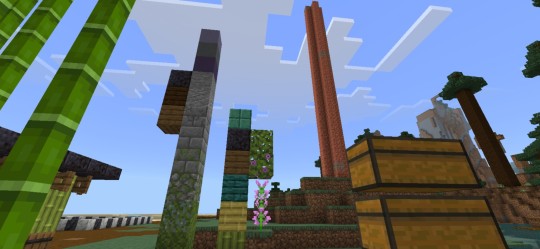
I may or may not have started a project that will probably overwhelming me...
#by the time that copper tower completely ages i should have prepared everything...#the tall pallete is for the fantasy towers i will build on a windswept mountain next to my base#the small pallete is for the entire village#i dont get why most minecraft players hate the new bamboo blocks.. they're pretty!!#a bit biased because I use bamboo for my little Filipino hut as a main base#but really there's so much to bamboo people are probably missing on... it works well with cherry. blackstone. warped and crimson. mud bricks#and there's so much variety you get from crafting bamboo blocks as well...#BUT YEAH this is my first minecraft project and tbh i am scared 😂 but ey... been wanting to do this for the longest time...#my last village didn't quite do well... now im determined to make this work...#this is gonna be a big task as i cant build redstone machines... it'll kill my phone 😂😂😭😭😭... no automation all manual...#that's enough rambling from me... have a good day! ✨#wyn talks :)#minecroof
14 notes
·
View notes
Text
For knitting it is 100% Seeknit, their Koshitsu needles are firm, slick but feel soft in your hand. The cable is thin and flexible, but firm (and it swivels!). I have never seen a cable snap. The brass fixtures are beautiful as well
If you could let me know your preferred craft as well and why you like that particular brand. Thanks! 🧶
#surprised to not see them in the poll#are they just more popular in europe maybe?#also they come in 2 bamboo varieties#one is grippier on slippier#so I think they'd serve most peoplw#they are not cheap though#but I'd pay the price again in a heartbeat#knitting#knitblr#queue
51 notes
·
View notes
Text
PYRRHIA
*Alt text available!
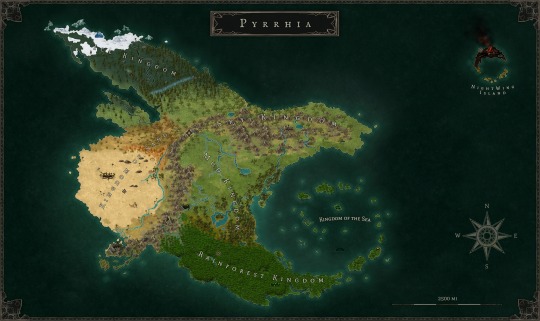

Roughly 1.5x the size of North America, Pyrrhia is the largest continent inhabited by dragons. Despite it's monumental size, very few areas on the map are considered un-owned territory, with even fewer areas being considered unexplored entirely.
Thanks to the continent's huge climate range, Pyrrhia has the most dragon tribe diversity of any landmass, hosting seven tribes in their entirety.
This includes: SkyWings, IceWings, SandWings, MudWings, RainWings, NightWings and SeaWings.

IceWing Territory

The Ice Kingdom, inhabited primarily by IceWings, is a large peninsula in the far north, also including a smaller cape just slightly south. It borders both the Sky Kingdom and the Kingdom of Sand.
While a large portion of IceWings live within the walls of the Ice Palace (an extravagant city compared to most other palaces), the majority live in villages and towns along the Ice Kingdom's coast. This is ideal for most, since the primary food source of IceWings are fish & sea-faring birds and mammals. However, it's not uncommon to find an IceWing family or two living further inland, hunting elk and other land-dwelling prey.
While only a relatively small portion of IceWing territory remains snowy year-round, the entire territory all the way down to Where-No-Dragon-Goes-Hungry can be seen blanketed in ice and snow during the winter months.

SkyWing Territory

The Sky Kingdom is home to the SkyWings, and is the largest land-based dragon-claimed territory on the map, give or take. Their territory borders several other kingdoms, including the Kingdom of the Sea, Ice Kingdom, Mud Kingdom, and the Kingdom of Sand.
Being quite physically big and territorial compared to most other dragons, SkyWings demand much more space (and use of such space) than their neighbors, despite there being much fewer of them overall. By technicality, the Sky Kingdom encompasses the entire Pyrrhian mountain range; although the SkyWings living any farther south than the Diamond Spray Delta tend not to argue about where borders are drawn, so long as they get a good night's sleep.
SkyWings tend to live solitarily or in pairs/family units, with the exception of those living in the Sky Palace working for the current Queen. Due to this, there are very few dedicated SkyWing towns or villages, with most SkyWings opting instead to pick out an ideal cave in the mountains to call home. This is of course not absolute, and there are many SkyWings living in harmony in bordering towns and cities with other tribes, some being SkyWing dominant.

MudWing Territory

The Mud Kingdom is home to the MudWings; the tribe of the largest land-dwelling dragons in the world. Their kingdom borders the Sky Kingdom, the Kingdom of the Sea and the Rainforest Kingdom.
Despite their size, they actually don't hold the largest amount of territory. Being rather sedentary, they typically never need more than the average pond to themselves and their siblings.
MudWing territory consists of a variety of land types, with the standard swamps and marshes; but also including bamboo forests, floodplains, sparse rainforest and grasslands. This variety in biome gives them plenty of agricultural opportunity, making MudWings one of the largest exporters of both plant and animal produce.
Their rich land also provides an abundance of earthen materials that other tribes covet for their own uses in construction, pottery and other types of craftsmanship; including kaolinite and other clays, calcite, etc!

RainWing Territory

The Rainforest Kingdom is home to the RainWings, the tribe of the smallest and most numerous dragons on the continent. Their kingdom borders the Mud Kingdom and the Kingdom of the Sea.
RainWings live communally, and thus are not separated into several towns. Rather, all RainWings (for the most part) share a single village that extends quite far throughout the rainforest, held together by the Queen's Royal Pavilion (marked on the map as the RainWing Village).
Although, since the events of the NightWing exodus from the Volcano, there lies a single other village amongst the jungle. Some RainWings find it comfortable enough to live there with the NightWing refugees, but don't prefer it.
The rainforest is a dragon's ultimate destination for near any kind of exotic fruit, flower, or animal. While RainWings used to be the top exporter of their tropical produce, these days the MudWings have taken on the task of growing orchards and vineyards, while the RainWings keep to themselves.

SeaWing Territory

SeaWing territory, home to the SeaWings, is technically the largest dragon-claimed territory on earth; this is because the vast majority of their inhabited space is underwater, and thus there is very little competition for territory. The land they control however, is the smallest compared to any other tribe, consisting mostly of small islands and islets. Their territory borders the Rainforest Kingdom, Mud Kingdom and Sky Kingdom.
Despite being the largest kind of dragon on the planet, they are incredibly numerous due to the abundance of food and territory. SeaWings live communally, but are spread across several habitable zones, including the Deep Palace and Summer Palace (their primary homes), and various island caves, huts, deep sea trenches, and sea stacks.
They are also partially migratory, spending warmer springs and summers in the Summer Palace, and living deeper underwater through autumn and winter.

SandWing Territory

The Kingdom of Sand, controlled by the SandWings, is the third largest land-based dragon territory on the continent. Consisting of vast dunes and open savannas, this desert environment isn't suitable for most other tribes. Their kingdom borders the Sky Kingdom and the Ice Kingdom.
Despite their large quantity of land, SandWings are actually not very high in population; more than SkyWings or especially NightWings, but fewer than most. SandWings are largely nomadic, not living in one particular place for their whole lives; instead relying on sparse oases and rivers spread throughout the desert, and traveling around for food.
Some SandWings, particularly those seeking refuge and safety from war, may choose to spend most of their time in small cities like the Scorpion Den, or border towns like Possibility and Sanctuary. Even then, many prefer to stay on their feet and travel often, reserving their town homes for sleep, rough weather or retirement.
Similarly, many SandWings working for royalty may choose to live in the Stronghold.

NightWing Territory

NightWing territory, the smallest and most uninhabitable, is home to the declining population of NightWings. It does not directly border any other kingdoms, but does have an animus-conjured portal to the Rainforest Kingdom.
Despite all the odds, NightWings manage to survive here on the small (near completely ash-polluted) ponds dotting the island, and by using desalination devices to convert seawater into drinkable water.
The prey on their volcanic home is close to non-existent; consisting almost entirely of occasional seabirds, crabs, beached sea turtles, and fish caught far out at sea using nets; although as time goes on, fewer NightWings are in good enough health to carry fish-filled nets back home.
Their fortress is half-collapsed due to a volcanic eruption, and the air is so hot, heavy and sulphuric that one might find it almost impossible to breathe if you hadn't been born there. What a pity.

Version with ALL Points of Interest
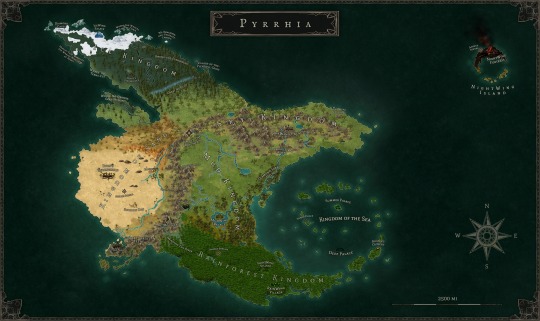
Blank Version

*You may use the blank version of the map for personal things as long as credit to Thorne & I is given! Tag me if you do :D I'd love to see!
This has been in the works probably the longest of anything I've made in relation to my WoF headcanons. I swear I've redone this entire map 3 or 4 times. After a year and a half, hopefully this is the last!!
I hope y'all like it!!
Huge thanks to my friend Thorne for her contributions to the climate placing, I wouldn't have been able to make it look at ALL natural without her help.
If you have any questions or suggestions for edits/additions please let me know! My ask box is open too.
#wof#wof: pantheon#wings of fire#mink's wings of fire#wof headcanon#wof worldbuilding#wof worldmap#worldmaps
2K notes
·
View notes
Text
Ok jokes aside here's some actual veteran advice about NOTN:
-Set goals. How many eggs? How many chests? Which will you open, which will you sell? How will you get them? This will help prevent overwhelm. I personally aim for 50 eggs, and I open half-sell half.
-Higgins is your friend. Back in my day we had to wait for swipp like heathens. Note which items you have for trade at Higgins, and which you need. You are going to have stacks upon stacks of one part of the trade and none of the other, it is normal. Trade with people. Sell on the AH.
-Use a guide. Not every item drops in each venue. Some venues are better than others for grinding specific items.
-Jump between venues. Variety is the spice of life! Bamboo Falls is traditionally the best for pure chest grinding, but Waterway, Rainsong Jungle, and Sandswept Delta have always been nice to me. Everyone has their own superstitions about which venue is best. Realistically, they're probably all the same at this point.
-Keep Baldwin moving. There's like 40 individual items you can brew during NOTN at this point. When grinding, melt down stuff. When asleep, brew the items.
-If you want pure profit, you will make more money selling chests. Don't open the chests for hopes of selling eggs, and by god don't open eggs in hopes of striking big. I mean. You can! I do it every year. It's fun! But I lose so much cash.
-Do your dailies!! Just like fests, you can now get random chests doing anything and everything. Some people go nuts trying to bond with every familiar. Only do this if you have a good computer and patience. Which. I don't. Lol
-Check the forums for trades. If you want specific items I guarantee you people will have 200 of them they want to get rid of. Trade your duplicates! There's usually a big master thread.
-Do not rush. NOTN is 2 weeks long. Everyone goes crazy day 1 and then burns out before the new year. It's much easier to grind 30 mins a day instead of 6 hours all at once.
But most of all HAVE FUN!
848 notes
·
View notes
Text
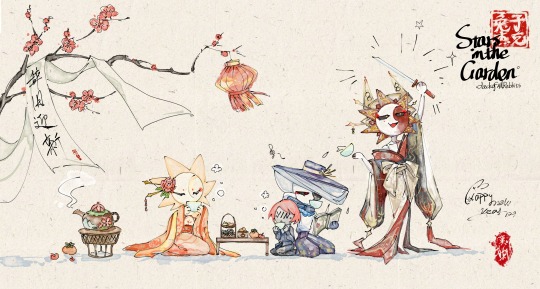
*围炉煮茶·寒窗对酒听雨雪
'stars in the garden' by @jackofallrabbits
Here's the list of gifts:
Geisha!Sun: A beautiful tea-making set with a portable oven, the main teapot is made of terracotta, with a cherry blossom relief and four gold-edged ceramic cups. It is used by people when they "围炉煮茶(make tea around the hearth)", and unlike the traditional tea tasting activities, "围炉煮茶" focuses more on the enjoyment of the atmosphere rather than ornamentation. Geisha!Moon:《枕上宋词( Song Ci on the Pillow)》, English translation of Song Ci, this book is a selection of 115 hand-me-down Song Ci, which can be understood by native English-speaking animatronic while preserving the beauty of ancient poems to the greatest extent. Beautifully packaged with a hint of aroma and a lotus motif on the front and back cover. Geisha!Eclipse: A collectible replica of the Imperial Tang Knife, handcrafted by craftsmen at an expensive price, perfectly reconstructed with a gold and silver flat Tang horizontal knife (the original in Shosoin in Japan), with”鎏金错银(gilt silver)”, restored one-to-one (and bladed). cherry blossom!Y/N: A box of delicious Chinese pastries, held in a bamboo basket, filled with a variety of flower-shaped desserts that young people will love, the most special of which is a large custard rabbit cake(奶黄玉兔糕). The bamboo basket was accompanied by a box of desiccated coconut balls and some fresh fruit.(Only there is no traditional cherry blossom cake, because you can only buy one piece at a time, considering the distribution problem....)
Why Gift?
It started with a joke I had while chatting with Jack:
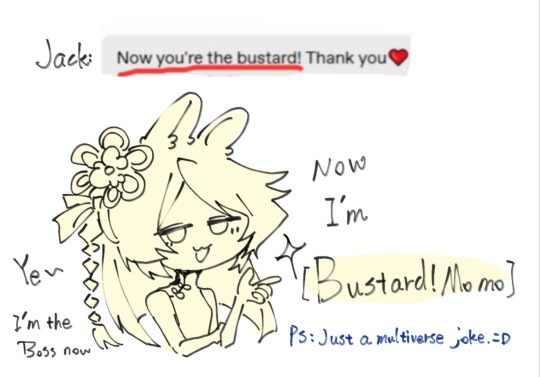
Then I thought, since I'm bustard, then this Chinese New Year's holiday, I have to send year-end bonus gifts to my employees, and then there is this doodles, and this post (just a joke for self-amusement haha, it has nothing to do with the novel itself~)
Here are some zoomed-in details:
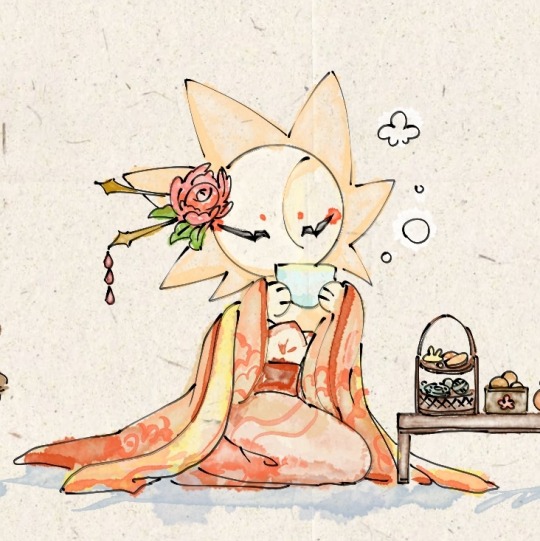
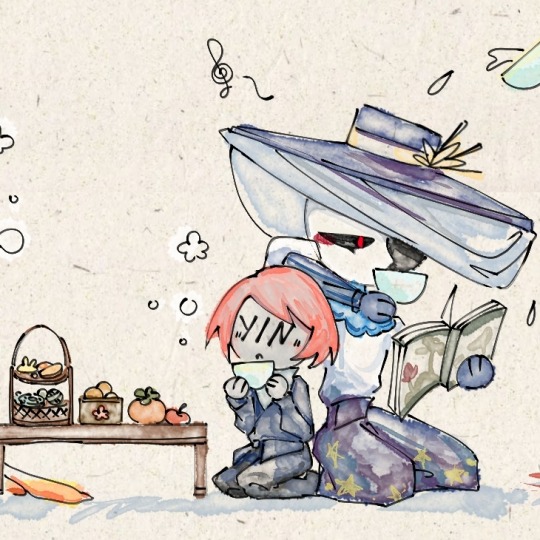

以及礼物参考图片:
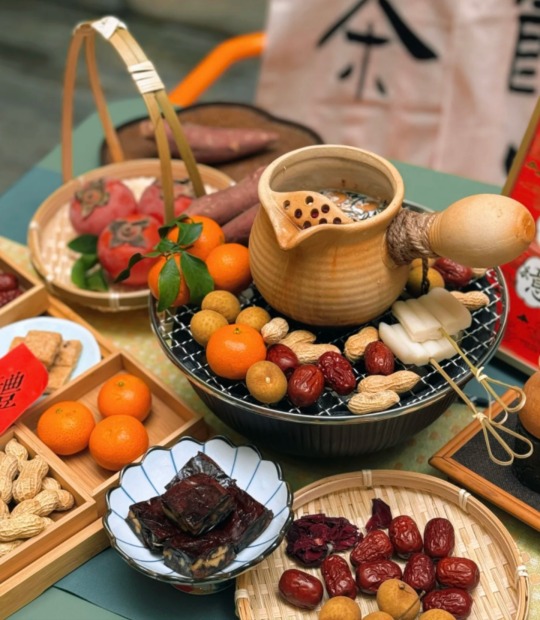
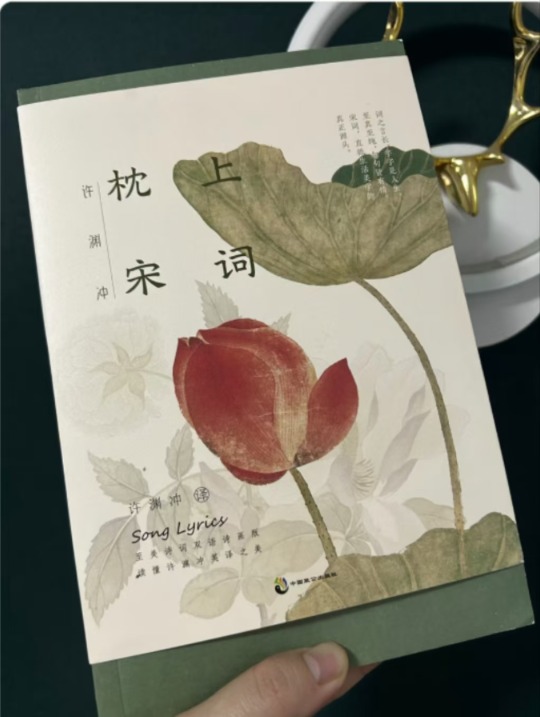
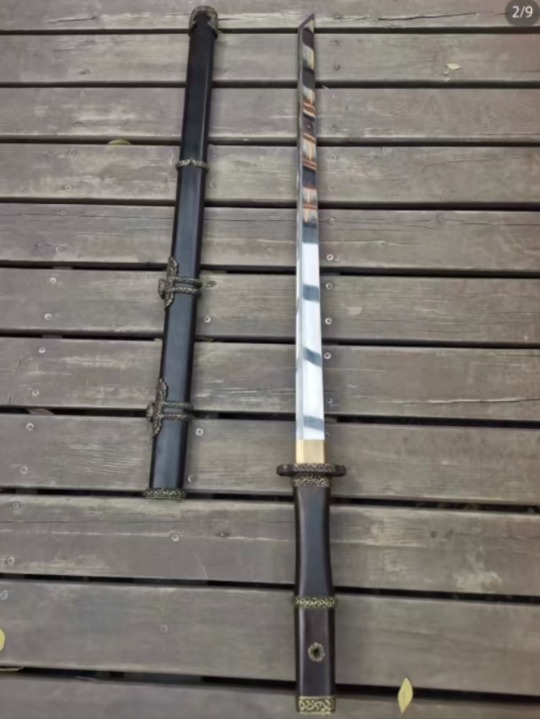
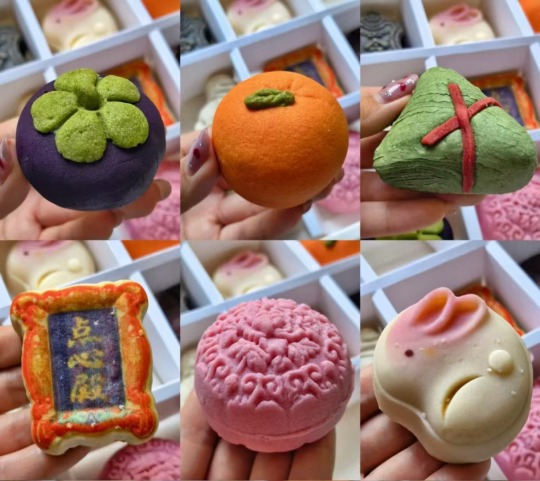
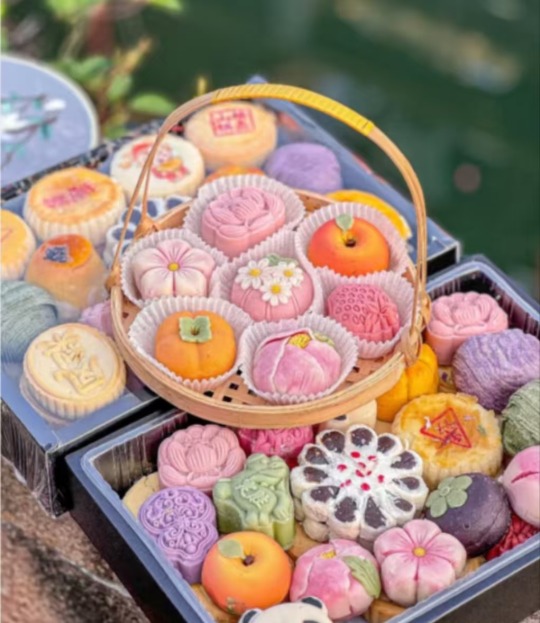
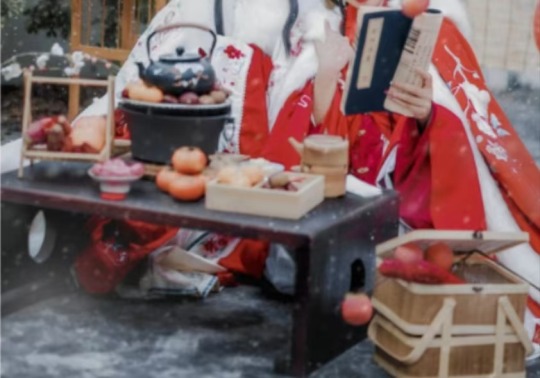
(There are some places I really don't know how to translate, so I put them in Chinese~)
Happy New Year daring! (and pass a cup of hot water to Jack)
#stars in the garden#geisha au#fnaf dca#fnaf moon#fnaf sun#dca xyn#sundrop#moondrop#fnaf daycare attendant#momomogosart#fnaf eclipse#Geisha au
473 notes
·
View notes
Text
That yarn is beautiful and your homemade support spindle is lovely! The minor slubbing isn't so lumpy that the yarn is all woogity, it looks wonderfully plied! It's going to give it a really fun texture if woven, too.
Can't attest to how your spindles handle, I know some of my homemade ones are downright frustrating to keep a balaced spin action, but changing around the amount of weight can help with that. I usually have to recarve the hook slit a couple times, it's always the first thing to break if I did it wrong the first time. I need the hook, I cannot get a feel for spinning with just the shaft and centrifical force. Maybe someday, but until then I'll notch the shaft with my teeth if I have to lol
I love making DIY fibre tools! I love being like "hey I want a nålbinding needle", sitting down with my pocket knife and a bamboo skewer, and just making it. If I fuck up? Oh no, I lost twenty minutes and a bamboo skewer, but I listened to twenty minutes of a podcast about frogs and learned how NOT to carve a needle. If I succeed, I have a needle! It's amazing.
Aaand back to making yarn on my awful homemade support spindles. This little rainbow army is growing nicely so far
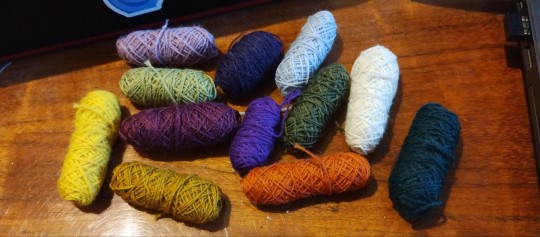

I still have some issues with the consistency, luckily the plying tends to even that out
#I have no money to buy premade fibre tools but i would stilll make them even if i did#Maybe buy myself some sick replica viking spindle whorls as a treat tho XDD#My nålbinding needle came out amazing by the way bamboo sands down super smooth and shiny with a foam xtra fine grit sanding block#Foam sanding block is good for delicate things that can snap. Wood burning kit makes doing the needle hole super fast smooth and easy#It doesn't catch on the wool at all! Unlike my dry-ass cracking fingernails lol#I think i'll make the next one a touch shorter tho#For variety
59 notes
·
View notes
Text
Flowers
Summary: what sort of flowers (or alternatives) they give you
Characters: Luffy, Zoro, Sanji, Ace, Sabo, Law, Kid, Usopp, Robin, Nami
Genre: fluff
———
Luffy: Not one to buy you flowers. Instead, he picks them. Sometimes they’re weeds he thought looked pretty, other times, he presents you with a lush bundle of pink carnations you think he must have picked from a commercial flower field (this man has no concept of private property). He’s always very proud to present them because he worked hard to secure them; you'd better give him a kiss for his effort. Has, on occasion, accidentally brought you some that are poisonous. Also once brought you a bundle of radishes because he thought you would like the color. Receiving flowers from Luffy can be a bit like receiving a lizard from your pet cat.
Zoro: He won’t really think to buy you flowers until one day you mention that camellias are pretty. He takes that to mean you like camellias, specifically, and not that you’d like to receive flowers in general, so he always buys you camellias, and you think it’s so sweet that you never correct him. He’s not actually a proponent of apology flowers because he thinks a ‘bribe’ cheapens it, but he will bring you flowers when he knows you’re having a hard day. He might also buy you a small bamboo plant that you two end up treating a bit like a pet, giving it a name and everything.
Sanji: Classic red roses, at least a dozen at a time. He’ll buy you roses in shades of white and pink, as well as the occasional yellow, but a dozen red roses is his go to. He also makes very good use of the petals. Doesn’t need a special occasion to present you with a bouquet. In fact, he always makes sure you have fresh flowers on your nightstand. Additionally, he’s learned to cook a few dishes with edible flowers in them for you, presenting you with all manner of chamomile, chive blossom, and pansy dishes.
Usopp: Will buy you cheap supermarket flowers on his way to come visit you and will regale you with a long, fanciful tale of crossing oceans and deserts to secure them from the only spot in the world those particular flowers grow, a tale filled with sweet and funny anecdotes that makes you giggle as you trim the stems and place them in a vase of water. He’ll tell you that the flowers have special powers and properties, such as bringing you luck or living forever so long as you smile every day.
Robin: Is an expert on hanakotoba, the language of flowers; she read a book on it once and thought it was so sweet and beautiful that she read it cover to cover several more times. She always buys you flowers with a specific meaning and then happily explains that meaning to you. Giving you flowers brightens her day as much as it brightens yours. White anemones (sincerity), daffodils (respect), and forget-me-nots (true love) are some of her favorites to give you.
Nami: Not a traditional kind of girl. She won’t hesitate to buy you roses if you like them, but she gravitates more toward violets, daisies, and the like, smaller flowers that speak to both of you. She’s also a proponent of buying you a single flower that you can put in your hair, and she has bought you a selection of floral hair accessories so you always have flowers for your hair on hand; her favorite is the primrose crown she bought you.
Ace: He’ll bring you bouquets with a lot of variety that the nice lady at the flower shop helped him put together. He usually builds these bouquets around sunflowers or orange lilies, and he gets very smug when his flowers brighten your day. He’ll also pick flowers for you, but he’s very conscious to only pick the ones that are not weeds. If he finds a field of sunflowers, you will be getting as many as he can carry. Never, ever visits you empty-handed, always brings at least a bouquet of flowers with him. Treats securing flowers for you like hunting for dinner and is always so proud of his bounty.
Law: Gravitates toward orchids, especially in darker shades of pink, purple, and blue; they feel a little moodier and less kitschy than the red roses Bepo tells him he’s supposed to buy to woo you (side note: imagine Law getting relationship advice from Bepo). One night folded an origami flower for you, and you liked it so much that he spent the rest of the night folding an entire bouquet, though he pretends it only took him five minutes. He doesn’t actually give the origami bouquet to you so much as he just sets it on your nightstand one day and mutters something about how the flowers won’t need water. He gets kind of annoyed if you make a big deal out of it.
Sabo: He’s gone for very long periods of time, so when he returns, he’ll bring you a bundle of peonies or calla lilies, but he also bought you a cherry blossom bonsai tree so you can have flowers even when he’s away. The bonsai tree ends up becoming his baby, and when he is home, he spends quite a bit of time tending to it, to the point you get a little jealous. But it brings you lots of comfort when he’s away, a symbol of your love that’s firmly rooted and eternal. Side note, he will most definitely use flowers to seduce you.
Kid: If it’s at the point where he’s buying flowers, this man is so far beyond pride he won’t flinch at purchasing a bundle of pink tulips, even if they clash with his outfit/aesthetic. He also presents you one night with a bouquet of metal flowers he made himself. He spent ages on it, but he really didn’t mean to. He intended to make one but got absorbed in his work and made an entire bundle of dainty little metal flowers. He’s oddly proud of himself for making something so delicate and would be crushed if you ever got rid of them.
———
Hope you enjoyed it! If you want more, you can check out my masterlist here!
#one piece#Luffy#Zoro#Sanji#Ace#Sabo#Law#Kid#Usopp#Robin#Nami#monkey d. luffy#roronoa zoro#zoro roronoa x reader#pirate hunter zoro#black leg sanji#vinsmoke sanji#sanji x reader#god usopp#usopp x reader#ace x reader#fire fist ace#portgas d ace#portgas ace x reader#flame emperor sabo#sabo x reader#trafalgardwaterlaw#trafalgar d water law#law x reader#trafalgar law x reader
881 notes
·
View notes
Text
Round 3 - Mammalia - Rodentia




(Sources - 1, 2, 3, 4)
Our next and last order of the Glires clade is the Rodentia. Rodentia is the largest order of mammals, with about 40% of mammal species being rodents. Rodentia is comprised of the families… *deep breath*… Anomaluridae (“scaly-tailed squirrels”), Zenkerellidae (“Cameroon Scaly-tail”), Pedetidae (“springhares”), Castoridae (“beavers”), Geomyidae (“pocket gophers”), Heteromyidae (“kangaroo rats/mice” and “pocket mice”), Ctenodactylidae (“gundis”), Diatomyidae (“Laotian Rock Rat”), Bathyergidae (“African mole-rats”), Heterocephalidae (“Naked Mole-rat”), Hystricidae (“old world porcupines”), Petromuridae (“Dassie Rat”), Thryonomyidae (“cane rats”), Chinchillidae (“chinchillas” and “viscachas”), Dinomyidae (“Pacarana”), Caviidae (“cavies”), Dasyproctidae (“agoutis” and “acouchis”), Cuniculidae (“pacas”), Abrocomidae (“chinchilla rats”), Ctenomyidae (“tuco-tucos”), Echimyidae (“Nutria”, “spiny rats”, and “hutias”), Octodontidae (“degus” and kin), Erethizontidae (“new world porcupines”), Dipodidae (“jerboas”), Sminthidae (“birch mice”), Zapodidae (“jumping mice”), Calomyscidae (“mouse-like hamsters”), Cricetidae (“hamsters”, “voles”, “lemmings”, “muskrats”, and “new world rats/mice”), Muridae (“true rats/mice” and “gerbils”), Nesomyidae (“Malagasy rats/mice”, “climbing mice”, “African rock mice”, “swamp mice”, “pouched rats”, and “White-tailed Rat), Platacanthomyidae (“spiny dormice” and “Chinese pygmy dormice”), Spalacidae (“mole-rats”, “bamboo rats”, and “zokors”), Aplodontiidae (“Mountain Beaver”), Gliridae (“dormice”), and Sciuridae (“squirrels”).
The distinguishing feature of rodents is their pairs of continuously growing, razor-sharp, open-rooted incisor teeth. These incisors have thick layers of enamel on the front and little enamel on the back. Because they do not stop growing, the animal must continue to wear them down so that they do not reach and pierce the skull. Some rodents have elastic cheeks or even cheek pouches for storing food. They usually have flexible fore limbs with five digits, including an opposable thumb, while the hind limbs can have three to five digits. The majority of species are plantigrade, walking on both the palms and soles of their feet, and have claw-like nails. Many rodents have well-developed senses of smell, hearing, and vision. Nocturnal species often have enlarged eyes and some are sensitive to ultraviolet light. Many species have long, sensitive whiskers for touch. Some have prehensile tails, some have vestigial tails or no tails at all. Rodents are highly diverse, having evolved to fill a large variety of niches and filling almost every land-based habitat on Earth. There are terrestrial, fossorial, arboreal, semi-aquatic, herbivorous, omnivorous, insectivorous, and carnivorous rodents. Rodent species use a wide variety of methods of locomotion including quadrupedal walking, running, burrowing, climbing, bipedal hopping, swimming, and even gliding. Many rodents have advanced cognitive abilities, and display advanced feats of memory and intelligence.
Sexual dimorphism occurs in many rodent species. In some rodents, males are larger than females, while in others the reverse is true. Rodents exhibit a wide range of types of social behavior ranging from the caste system of the Naked Mole-rat (Heterocephalus glaber), the extensive "towns" of the colonial prairie dogs (genus Cynomys), through family groups to the independent, solitary life of the edible dormice (genus Glis). Beavers (genus Castor) live in extended family units typically with a pair of adults, and both their recent kits and older young. Brown Rats (Rattus norvegicus) usually live in small colonies with up to six females sharing a burrow and one male defending the territory around the burrow. The Prairie Vole (Microtus ochrogaster) is monogamous and forms a lifelong pair bond. Female rodents tend to play an active role in choosing their mates. Factors that contribute to female preference may include the size, dominance and spatial ability of the male. Rodents may be born either altricial (blind, hairless and relatively underdeveloped) or precocial (mostly furred, eyes open and fairly developed) depending on the species. In many social species, young may be cared for by individuals other than their parents, a practice known as alloparenting or cooperative breeding.
According to the fossil record, Rodentia arose in the Paleocene, probably in Asia, shortly after the extinction of the non-avian dinosaurs some 66 million years ago. Some molecular clock data suggest Rodentia had already appeared by the Late Cretaceous, although other molecular divergence estimations are in agreement with the fossil record.

Propaganda under the cut:
Many rodents are “ecosystem engineers”: species which have a huge impact on their habitat. Ecosystem engineers are important for maintaining the health and stability of the environment they are living in. Beavers (genus Castor) (see gif above) are often used as the prototypical ecosystem engineer example, because of the impact their dams have on channel flow, geomorphology, and ecology. Beavers can create entire wetlands, habitat which is then used by millions of other species. Ground squirrels such as Groundhogs (Marmota monax) and prairie dogs (genus Cynomys) perform substantial modifications by burrowing and turning soil. They are able to influence soils and vegetation of the landscape while also providing burrows that are used by other species. Many tree squirrels bury nuts over a widespread area (scatterhoarding), and often forget them, resulting in entire new generations of forest diversity being planted.
Two distinct, unrelated groups of rodents evolved the ability to glide with a membrane between their front and hind legs. These are the Anomalurids (“scaly-tailed squirrels”) and the Flying Squirrels (Sciurid squirrels of the tribe Pteromyini) (image 4). Sciurids are most closely related to the Mountain Beaver (Aplodontia rufa) and dormice (family Gliridae). Anomalures are most closely related to springhares (family Pedetidae) and the Cameroon Scaly-tail (Zenkerella insignis). The only other mammals to evolve this gliding ability are the colugos and the some possums. This is an example of convergent evolution, where arboreal, climbing mammals found a way to more easily travel from tree to tree.
Springhares (genus Pedetes) (image 1) sleep standing up, with their head and forelimbs bent down in between their hindlegs, and their tail wrapped around their feet.
Beavers hold territories and mark them using scent mounds made of mud, debris, and a vanilla-like musk called castoreum—a liquid substance excreted through the beaver's urethra-based castor sacs. Castoreum was historically used for a variety of medical purposes; Pliny the Elder promoted it as a treatment for stomach problems, flatulence, seizures, sciatica, vertigo, epilepsy, hiccups, toothaches, and envenomations. By the early 20th century, castoreum began appearing in some foods to add a vanilla-raspberry flavor. But its use had fallen by 1987, when the U.S. consumed about 250 pounds of castoreum per year. Since then, its use has decreased significantly, now mostly found in niche foods such as Swedish liquor and some perfumes.
The Eurasian Beaver (Castor fiber) was hunted almost to extinction for both its water-resistant fur and castoreum by the early 20th century. Beaver hats were fashionable across much of Europe between 1550 and 1850 because the soft yet resilient material could be easily combed to make a variety of hat shapes (including the familiar top hat). Demand was so high, that when Eurasian Beavers could no longer be found, the gaze of European fashion turned to the New World and the North American Beaver (Castor canadensis), which was then also hunted to near-extinction. A shift in fashion trends toward silk hats may have been the only thing that saved these two species. Today, after considerable conservation efforts and reintroductions, both beaver species have recovered from this severe over-exploitation.
Gundis (family Ctenodactylidae) can climb up almost vertical surfaces.
The Naked Mole-rat (Heterocephalus glaber) is highly unique for many reasons, one being that it is the only mammal with an almost entirely ectothermic (cold-blooded) form of body temperature regulation. They also lack pain sensitivity in their skin, have very low metabolic and respiratory rates, are resistant to cancer and oxygen deprivation, and can live over 37 years. Naked Mole-rats are also eusocial, forming a complex social structure which includes a reproductive division of labor, separation of reproductive and non-reproductive castes, and cooperative care of young. The only other eusocial mammal is the Damaraland Mole-rat (Fukomys damarensis).
Another example of convergent evolution involves spines. Both Old World Porcupines (family Hystricidae) and New World Porcupines (family Erethizontidae) (image 2), as well as spiny rats (genus Tokudaia) and spiny mice (subfamily Deomyinae), are not particularly closely related to each other. We also see spines in the even more distantly related hedgehogs, tenrecs, and echidnas. Many groups of small animals around the world seemed to have turned their mammalian fur into this unique defense mechanism.
Chinchillas (genus Chinchilla) have the densest fur of all living terrestrial mammals, with around 20,000 hairs per square centimeter and 50 hairs growing from each follicle. This gives them some of the softest fur in the world. Unfortunately, this has made their fur highly desirable for the fur trade, and both species of chinchilla are now endangered. A single, full-length coat made from chinchilla fur may require as many as 150 animals. Domestic Chinchillas descended from the Long-tailed Chinchilla (Chinchilla lanigera) are sometimes kept as pets, and are also bred and raised on fur farms.
The largest rodent ever known to exist was the the extinct, bison-sized Josephoartigasia monesi. Today, its only living relative is the much smaller Pacarana (Dinomys branickii).
The Greater Capybara (Hydrochoerus hydrochaeris) is the largest living rodent, growing to 106 to 134 cm (3.5 to 4.4 ft) long, standing 50 to 62 cm (1.7 to 2 ft) tall at the withers, and typically weighing 35 to 66 kg (77 to 146 lb). Capybaras are highly social, and semi-aquatic, and can hold their breath underwater for up to five minutes at a time.
The Domestic Guinea Pig (Cavia porcellus) was domesticated from the wild Montane Guinea Pig (Cavia tschudii) as early as 5,000 BC by indigenous peoples in the Andean region of South America. Originally bred for its meat, the Domestic Guinea Pig is bred today for scientific research, for various color and coat types in shows, and as a pet. Their docile nature, friendly responsiveness to handling and feeding, and the relative ease of caring for them have made Guinea Pigs one of the most popular pet rodents.
The agoutis (family Dasyproctidae) are some of the most gracile rodent species, having an almost antelope or deer-like appearance, complete with hoof-like toes.
The beautiful Norway Lemming (Lemmus lemmus) is known for being one of the most aggressive rodents, despite its small size. When cornered by predators (including humans), they have been known to go on the attack. This is thought to be an attempt to deter predation by using their bold coloration, loud calls, and aggressive behavior to advertise their ability to harm small predators.
The Maned Rat (Lophiomys imhausi) is the only known poisonous rodent. Its long hairs are spongy, fibrous, and absorbent with a honeycomb structure. The rat is known to deliberately smear these hairs with poison from the bark of the Poison Arrow Tree (Acokanthera schimperi), on which it chews. Its mane of hairs absorbs the poison, thus creating a defense mechanism that can sicken or even kill predators which attempt to bite it.
The Rakali (Hydromys chrysogaster) is a semi-aquatic rat native to Australia, and fills a similar niche to river otters, hunting a variety of aquatic animals including fish, crustaceans, shellfish, eggs, mammals, frogs, and small reptiles.
The Brown Rat (Rattus norvegicus) is one of the most successful rodents in the world, living wherever humans live. They have adapted to survive well in urban environments, a genius survival strategy in an increasingly human world.
Domestic Rats are also called Fancy Rats (Rattus norvegicus domestica), and were bred from Brown Rats in 18th century Europe, when rat-catchers who caught and bred rats for rat-baiting noticed that some of their rats were prettier and more docile than the others. These rats were dressed up in ribbons and sold as pets. It was said that people who kept pet rats were struck with “rat fancy.”
Brown (and by extension Fancy) Rats are highly social and groom each other, sleep together in “piles”, play fight, emit ultrasonic “giggles” when excited, and show empathy to both their fellow rats and their bonded humans. In laboratory tests they have been shown to have intelligence levels rivaling that of primates, remembering complex mazes months after completing them, problem-solving, using tools, learning by watching other rats, planning ahead, and recognizing when they know something vs when they don’t. In laboratories and in peoples’ homes, rats can quickly be taught to come when called, play fetch, do agility courses, sort recycling and trash, and drive cars.
Fancy Rats are the best “exotic” pets and I currently have 9 of them. Their names are Magpie, Blue Jay, Raven, Versace, Gucci, Prada, Chanel, Nordstrom, and Porcini. I don’t have a photo of all of them together because have you ever tried to get a group photo of 9 rats? If Rodentia makes it to Round 3 I will Try.
As an adaptation to life in the desert, Australian Hopping Mice (genus Notomys) can concentrate their urine to as high as 10,000 mOsm/L (10-20 times higher than a human).
The Earless Water Rat (Crossomys moncktoni) is the most aquatically adapted rodent in the world. It has long hindfeet with completely webbed toes, strongly reduced forelegs, absent or invisible ears, very small eyes, and soft, waterproof fur. It resembles the Elegant Water Shrew (Nectogale elegans), another example of convergent evolution.
The Fancy Mouse is the domesticated form of the House Mouse (Mus musculus), which was domesticated in China sometime before 1,100 B.C. Today, Fancy Mice are available in dozens of different colors, markings, and coat types, and are popular for their small size and relatively inexpensive care.
Southern Giant Pouched Rats (Cricetomys ansorgei) are trained by the Tanzanian group APOPO ("Anti-Personnel Landmines Removal Product Development" in English) to sniff out land mines and detect tuberculosis with their highly developed sense of smell. The trained pouched rats are called HeroRATS. In 2020, a HeroRAT named Magawa received a People's Dispensary for Sick Animals Gold Medal, the animal equivalent of the George Cross, becoming the first rat to receive the award since the charity began honouring animals in 2003. Before retiring in 2021, Magawa detected 71 landmines and 38 items of unexploded ordnance, clearing over 2,421,880 sq ft (225,000 m2) of land in Cambodia during his 5-year career, preventing many deaths and injuries. Magawa died from natural causes at the age of 8 in 2022.
Prairie dogs (genus Cynomys) have a highly advanced language, with their alarm calls conveying information about not only the type of predator that’s been sighted, but also how big it is and how fast it’s approaching. Their calls contain information on whether a dog is a coyote, wolf, or domestic dog, with the colony changing their response depending on the predator. Their alarm calls even have language for the researchers studying them, and will change depending on the height and clothing color of the observing human.
168 species of rodent in 126 genera warrant conservation attention, but getting the public, and even scientists, to appreciate rodents is often an uphill battle, as many people associate rodents with the most familiar Brown Rats and House Mice. Since 76% of rodent genera contain only one species, much phylogenetic diversity could be lost with a comparatively small number of extinctions.
#I used a brazilian porcupine instead of a capybara because I’m wild like that#btw everybody say thank you Joel Sartore for this one#every animal I wanted to use a pic of he had on file#anyway if you think this group is just rats and mice think again#this group is MOST MAMMALS#if you like mammals AT ALL you probably have a favorite in here#animal polls#mammalia#round 3
183 notes
·
View notes
Text
Say it with flowers
My thoughts on the SGMB live recording video.
I've had this in my drafts for months. It's one of those moments that I just can't move on from. If this has already been discussed at length I won't be surprised but just in case it hasn't....

WHO gave Jimin those flowers...?
When the SGMB recording video first dropped, i saw comments that the flowers were from Loco or from Big Hit or from the SGMB band.
I cannot agree. Did the commenters not SEE the flowers?
I believe the flowers to 'support Jimin's future endeavours' were from Jungkook.
Because of course they were.
And for those who need an explanation, here's why:
This is not a bouquet of flowers you would get from colleagues, or your management company, or even your friends. This bouquet screams PASSIONATE LOVE. It is so obvious that i can't even imagine giving a platonic friend these flowers without a lengthy explanation (or a confession), let alone a professional acquaintance.
Let's take a closer look at Jimin's bouquet:
I took the time to research all the components of the bouquet to make sure i wasn't overreacting (Me? Overreact?! Never!!)
Here they are:

Red roses - passionate love, romance, and desire - 12 of these roses if I counted correctly, which represents a declaration.
Mini red chrysanthemums - in red, the chrysanthemum means love and passion, or truth
Sacred bamboo (Nandina) - the berries represent changing hardship into good, the end of hard times, and prosperity. It also wards off evil. (7 is the leaves of the Sacred Bamboo)
More red roses - either bush roses or a smaller variety. Love, again.
Red viburnum - "To make red hot". Passionate love, Love stronger than death.
Silver Wattle - hidden feelings, hidden love. (wow)
Sacred bamboo (leaves see #3 for berries)
Difficult to identify but I think it's either Veronica or Salvia. Veronica symbolises loyalty, fidelity and love. Salvia is for protection, and red salvia means forever mine.
I think this might be pink muhly grass. It doesn't seem that common in floristry but it is a very romantic and beautiful seasonal grass in Korea.
Barley grass - time for relaxation, free time, or prosperity.
Those flowers are a grand gesture
They're a declaration of love.
Jungkook is after all the king of grand gestures...

... and he knows a thing or two about the language of flowers.

So it seems perfectly fitting for him to make his heart known with a huge bouquet.
Naturally the theme of the bouquet is very much in keeping with the theme of SGMB,
The central tenet of the song is the truth untold and, these flowers certainly tell the truth, loud and clear.
I find myself thinking about whether he chose to do it in front of a crowd of people and I actually don't think he thought too much about them. Based on what I know of JK's personality (admittedly very little, having never met the man) I believe he thought of Jimin, and Jimin only.
Did he take a gift that would not only celebrate Jimin's achievement, but also show his commitment to that love and to not hiding?
Both heart and my head say yes, that's exactly what he did.
💜💛
I also believe JK was at the SCMB live recording
Here's why:
Having seen AYS, we know Jimin does this parody of the SNTY choreo to tease JK. Would it have been as amusing for Jimin if JK wasn't there to see it? I doubt it, as the payoff (JK's grumbling) wouldn't happen. Where's the fun in that?

And also:
Jimin: "Can i come over for a meal?"
Loco: "We can all go together" points to someone off-screen
[Remember that Loco is friends with Jay Park, who Jungkook is also friends with]
Jimin: *looks at person off-screen* Dammit. So much for secrets

And also:
Jimin, looking to the right of the camera, which is where everyone else will be looking in a moment.

Yup, we see Loco, Pdogg, and several of the dancers repeatedly glance to the right of the camera. They seem very interested in something there, sharing their attention between Jimin and the distraction off-screen. It would seem rude if it weren't for the fact that Jimin himself is equally distracted.

And also:
Pdogg's cute head shake at this situation tells me there's more going on here than we can see.

This song remains one of my favourites. The lighthearted joy and humour that runs through the live performance, the choreo, the melody, and the lyrics is everything I want for Jimin.
I hope his happiness lasts decades, our beautiful flower boy 💛
While we're on the topic of flowers, let's recap on the meanings of the oversized flowers on the set of SGMB:
According to Korean floriography (that's the study of the symbolism of flowers)
Blue anemone - anticipation, and protection from evil
Purple aster - love triumphs
Orange lily - cheerful love (strikingly similar to JK's birth flower)
White Poeticus daffodil - connection to youthfulness and the awakening of desire, rebirth, hope (young forever?)
Butterfly - happiness and transformation

I do have a gazillion references for the floriography, which i will add.
Its such an awesome and fascinating topic. I never knew that it became not only popular, but empowering, because so many 18 century women were unable to access an education and were therefore illiterate.
The symbolic meaning attached to flowers became an important communication tool for them.
🌻🐰💗🐥⚘️
Edited to add references (these may not be all of them, I had SO many tabs)
https://simplybeyondherbs.com/daffodils-flower-meaning/
https://www.freddiesflowers.com/blog/floriography-the-lost-language-of-flowers
https://greg.app/articles/
https://en.namu.wiki/w/%EA%BD%83%EB%A7%90
https://kukka.kr/farmersmarket/
https://www.lovetoknow.com/home/garden/meaning-symbolism-different-color-chrysanthemums
#kookmin#국민#jikook#jeon jungguk#park jimin#smeraldo garden marching band#true love#floriography#secret language of flowers#jimin muse
246 notes
·
View notes
Text

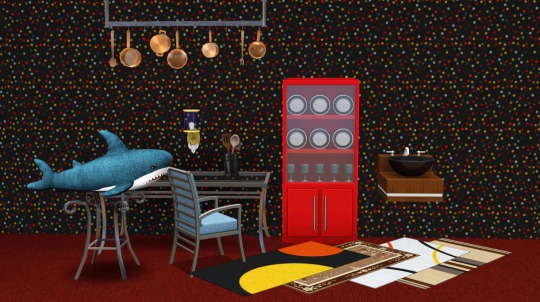
Advent gifts out in the wild! Thank you everyone for participating!
To the ones who missed out the 12-day event, or just wanted to revisit the goodies, here's everything under one post. Enjoy! 🎅
More info below the cut..
🎄 DAY 1: 2to3 Kitchen & Bath "Tres Rugs by Sleek Sensations"
This rug actually has five presets (I said only four in the advent post *facepalm*), where one preset has only one channel, three have varying color channels, and another one that is not recolorable. Found in Decor > Rugs, costs §430.
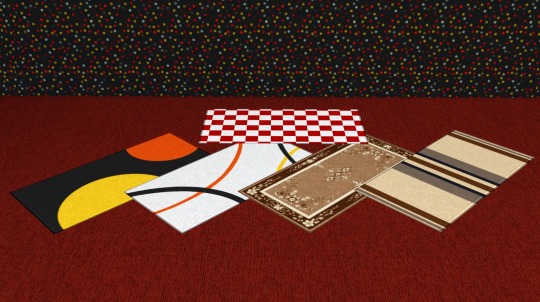
🎄 DAY 2: Cozy Patio Table
I made this table using the legs from the "Deluxe Cozy Terrarium" from Outdoor Living, then put a glass top and voila! A cozy patio table. Five slots as with any 1x1 dining table with one channel. Found in Surfaces > Dining Tables, costs §200.
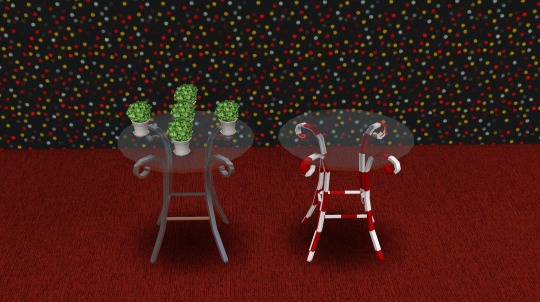
🎄 DAY 3: 4to3 Snowy Escape "Bamboo Forest Fence"
Yep, we are still lacking various fences in TS3, hence converting this gem from Snowy Escape. Three channels, costs §25. Found in Build mode > Fences.
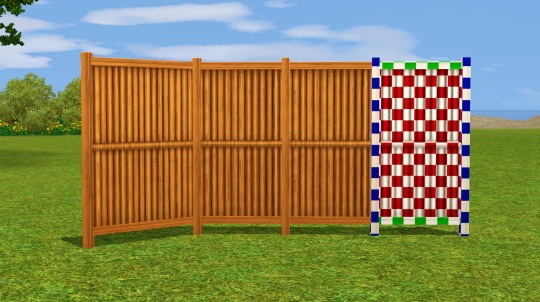
🎄 DAY 4: 4to3 "RAW Utensil Holder"
For the clutter lovers, here's something for your kitchen, if you also love the industrial accents from TS4 like me. Four channels, costs §430, found in Decor > Sculptures, Misc.
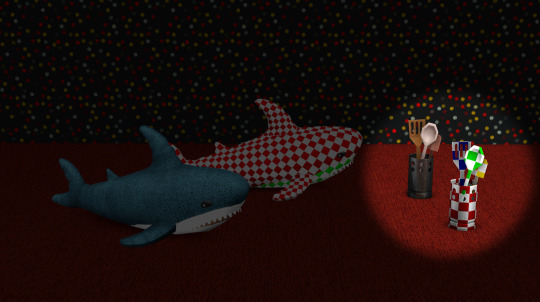
🎄 DAY 5: 2to3 Kitchen & Bath "FaceBowl by Sleek Sensations"
This conversion took almost a year in the making and thought would never get finished, but here it is, finally ready to conquer your bathrooms! Four channels, costs §670, found in Plumbing > Sinks.
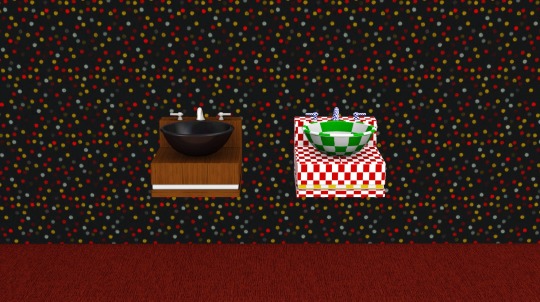
🎄 DAY 6: Outdoor Living "Class-E Dining Table" Unornated
I love the stuff from Outdoor Living, but why didn't EA make un-ornated versions of the furniture for variety? And so I did the work. Same channels and slots as the original, only differs in price which is now §825. Found in Surfaces > Dining tables. Outdoor Living not required.
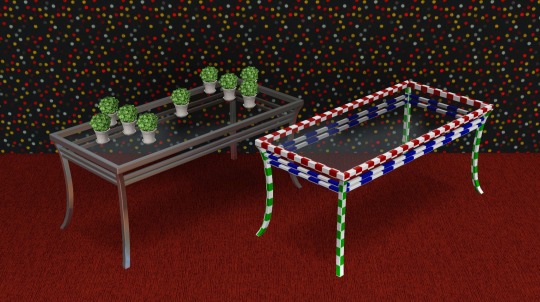
🎄 DAY 7: 2to3 Apartment Life "BLOK Jr. Block from COGnition"
I miss the industrial/gearhead aesthetic from TS2:AL and this wall is one of those, so I converted it. Three channels, costs §11, found in Walls > Panelling.
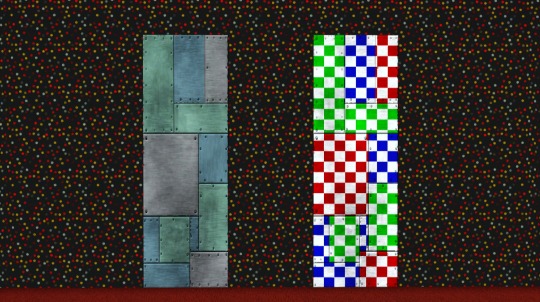
🎄 DAY 8: Outdoor Living "The Poet's Respite" Unornated
Another un-ornated piece of furniture from Outdoor Living (I just couldn't stand the cursive elements sometimes @.@). Lowered the price to §300, everything else is left intact. Outdoor Living is also not required.

🎄 DAY 9: 2to3 Kitchen & Bath "Pots Descending from Ceiling"
I hate repeating myself, but yeah it's nostalgia that's the main reason why I convert 2to3 items. Especially from this stuff pack, I'd love to convert everything else left unconverted from it (but the counters stop me from doing so). Two channels, costs §160, found in Decor > Sculptures, Misc.
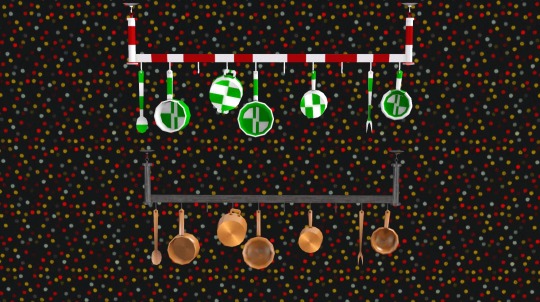
🎄 DAY 10: 4to3 Max20 Shark Plush Toy
I've been pondering if I should put this one up for download, because I couldn't find the original cc post to link. But having seen this 4to2 conversion, I figured I should also share it. Two channels, costs §100, found in Decor > Misc, Kids > Misc. Credits to Max20 for the original TS4 creation.
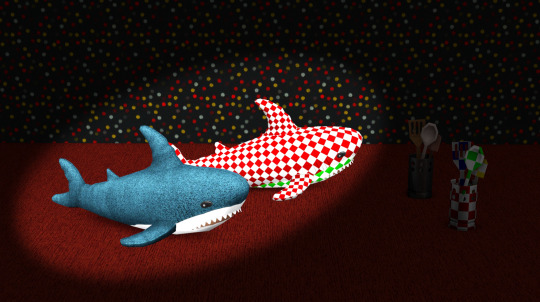
Fun fact: I own a real life counterpart of this plushie (I got this as a secret santa gift), and now my cat has already claimed it as his property. 🐱🦈
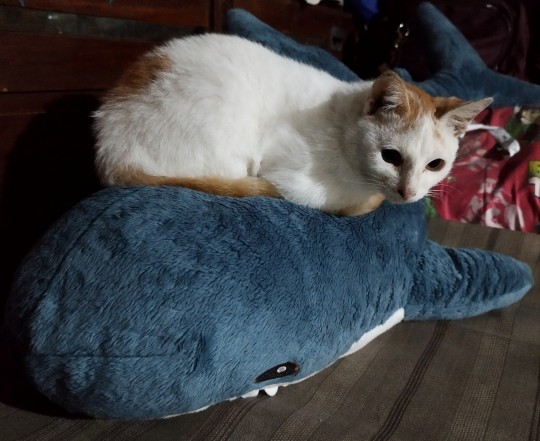
🎄 DAY 11: Ambitions "Le Sconce" made fully CAStable
I hate it when EA decides to make an object part unrecolorable when there are actually many ways to redesign it, like in this default replacement I did on a mirror. This wall lamp now has the emblem CAStable, and also edited the mask into three channels for a more versatile recolorability. This is a default replacement, so you need Ambitions for this to work properly.
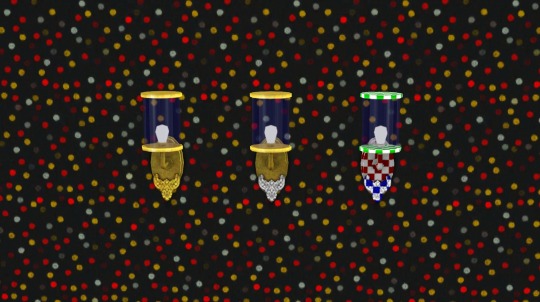
🎄 DAY 12: 4to3 "The Centurion"
Need something to fill your dining room but too lazy to decorate it using shelves and clutter? Say no more! This pre-decorated hutch from TS4 is now also available for TS3! Three channels, costs a hefty §1880 (why EA?), found in Decor > Sculptures.
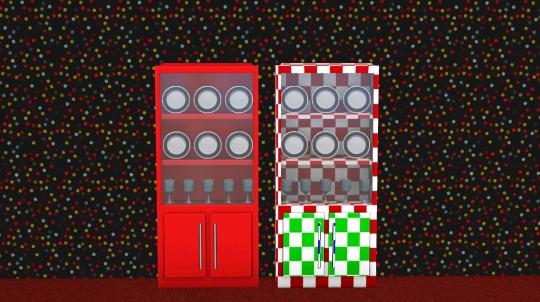
POLYCOUNT INFO:
Tres Rugs by Sleek Sensations: 80 (hLOD)
Cozy Patio Table: 526 (hLOD)/220 (mLOD)
Bamboo Forest Fence: 44 (main)/48 (diagonal)/12 (post)
RAW Utensil Holder: 250 (hLOD)/220 (mLOD)
FaceBowl by Sleek Sensations: 1356 (hLOD)/877 (mLOD)
Class-E Dining Table Unornated: 750 (hLOD)/257 (mLOD)
The Poet's Respite Unornated: 994 (hLOD)/360 (mLOD)
Pots Descending from Ceiling: 2122 (hLOD)/1190 (mLOD) (!!!)
Max20 Shark Plush Toy: 750 (hLOD)/444 (mLOD)
The Centurion: 420 (hLOD)/360 (mLOD)
DOWNLOAD FOLDER: Simfileshare | Mediafire
*All converted items contain catalog descriptions from their respective original games.
**I would also like to thank @simlicious for her wonderful selection of Christmas themed patterns, one of which I used on the wall in the previews, found here. Please check out her website if you haven't yet..
#ts3cc#download#dl:buy#dl:build#dl:defaults#sims 3#ts3#4to3#2to3#ts4 to ts3#ts2 to ts3#simblr#sims 3 cc finds
179 notes
·
View notes
Note
you're going on a hike, how about u write about Binghe going on a hike with shizun?
sorry this is a day late! it turned out super sappy lol
--
Luo Binghe had spent a long time fantasizing about his future with Shen Qingqiu. Many of those fantasies had been strictly private and unsuitable for polite company, but many others had been innocent. Fantasies about living in the Bamboo House forever, attending to all Shen Qingqiu’s domestic needs. Fantasies about becoming a strong cultivator, becoming a suitable cultivation partner for a peak lord of Shen Qingqiu’s caliber.
And fantasies of days like this, following at Shen Qingqiu’s heels like a good head disciple should, assisting him with research for his bestiary.
“Binghe, look!” Shen Qingqiu exclaimed, voice hushed so as not to startle the beasts they’d been tracking. They crouched together in the brush, obscured from the creatures’ view.
The beasts they were searching for today were some obscure variety of rodent, somewhere between a rabbit and a large squirrel, with incongruously menacing teeth and fur so pale they blended in perfectly with the snow around them. Apparently they were notoriously shy and difficult to find, made worse by the fact that they were only found near the peak of one specific mountain. The creatures were most active in the winter, when the mountain’s terrain was most difficult for humans to navigate, but they’d gotten lucky today; they had a break from the near constant blizzards that haunted this mountain, leaving the sky the kind of crisp blue reserved for remarkably cold winter days. Shen Qingqiu and Luo Binghe flew up the mountain early in the morning and had been tracking the creatures for hours before finally spotting them.
“Quick,” Shen Qingqiu whispered, pressing a notebook and stick of charcoal in Luo Binghe’s hands. “Sketch them, and I’ll take notes. You’re the better artist, anyway,” he said, the praise spilling easily from his mouth as he retrieved his own notes.
“Only because Shizun taught me so well,” Luo Binghe said, brimming with pride. Shen Qingqiu huffed and flicked his forehead, but his attention was elsewhere.
“I can’t believe they’ve let us get so close,” Shen Qingqiu murmured, taking notes in a shorthand Luo Binghe could still only partially decipher. “Look, are those the kits? I don’t think their young have ever been documented. We’ll be the first!”
Luo Binghe watched the animals hop around in the clearing, carefully sketching them. The babies were quite cute, resembling little snowballs as they snuggled with what must be their mother. “Does Shizun want one?”
“Want one?” Shen Qingqiu startled, then shook his head. “Of course not. Look how happy they are with their mother. I couldn’t bear separating them.”
One particularly clingy kit squished against its mother’s chest and made a whiny, trilling sound. The mother obligingly began grooming between its ears.
Luo Binghe scooted closer to Shen Qingqiu so they were pressed together from hips to shoulders. Shen Qingqiu absently rubbed Luo Binghe’s back for just a moment before returning to his notes.
“Besides,” he continued, pointing at a bird that had made the mistake of landing near the rodent family, “They’re rather territorial.”
Faster than should be possible, the rabbit-squirrel mother launched herself at the bird and ripped it to bloody shreds. The bird didn’t even manage to let out a death cry before the kits swarmed and happily began feasting upon it.
“I see.” Luo Binghe glanced down at the sketch he’d made of the rabbit mother sweetly grooming its kit. He looked back up to find that same kit’s white fur now completely bloodstained. “I suppose they would not make very good pets.”
“No,” Shen Qingqiu chuckled. “If we brought one home, they would eat all the short-haired beasts Liu-shidi keeps bringing, and then where would we be?”
“I’m sure Liu-shishu would just bring more,” Luo Binghe grumbled under his breath. That made Shen Qingqiu laugh a little louder, inadvertently startling the rodent family. They all froze and stared at the bush where the two of them hid, their fur menacingly bloodstained.
“Come on,” Shen Qingqiu whispered, tugging on Luo Binghe’s sleeve. “Let’s leave them alone before they decide we’re prey too.”
Luo Binghe was pretty sure he could handle half a dozen rabbits, sharp teeth or not, but he obligingly followed Shen Qingqiu away from the clearing. Shen Qingqiu’s hand slid down from his sleeve to slip into Luo Binghe’s hand and squeeze gently.
“I have one more thing I’d like to see,” Shen Qingqiu suggested, glancing up at his husband. “Unless Binghe would like to go home?”
“This disciple will go wherever Shizun wishes,” Luo Binghe answered immediately.
Shen Qingqiu scoffed, but side by side like this he couldn’t hide his smile behind his fan. He led Luo Binghe through the dense underbrush, following an overgrown trail up the mountain. They went higher and higher, high enough that it surely rivaled even Cang Qiong’s highest peaks, and then the trees finally parted and they found themselves at the very tip of the mountain. Luo Binghe’s eyes widened at the view, and Shen Qingqiu looked inordinately pleased.
“It’s even better than described,” Shen Qingqiu muttered, and Luo Binghe wasn’t sure if he was supposed to hear that. Shen Qingqiu tugged him along until they stood at the absolute highest point of the mountain, overlooking the range of jagged peaks below them, followed by hills and rivers and distant fields. Shen Qingqiu let go of his hand to point out landmarks.
“There’s Huan Hua Palace and Hua Yue City,” he said, pointing to a city amidst the distant plains. “That other mountain range is Cang Qiong Mountain. And there,” he added, pointing to a winding river whose origins spilled from a tall snow capped mountain, “That’s the Luo River.”
“It’s beautiful,” Luo Binghe said truthfully. The recent snow had covered most of the nearby landscape in white, but the clear skies made the ground glitter and shine. This high up, they could see to nearly impossible distances, past familiar landmarks to places he only heard about on trade reports. He was suddenly filled with the hunger to sweep Shen Qingqiu up and fly to that farthest point, just to see his husband’s delight at exploring a new place.
Beside him, Shen Qingqiu had a small, smug smile. “I thought Binghe would like it. This master apologizes, but Binghe’s birthday snuck up on him this year. I would’ve done something more special if I’d planned earlier, but hopefully this is enough for now. Oh!” he exclaimed, a puff of air escaping his mouth into the frosty air. “Binghe must be cold. Hold on.”
He began rummaging around in his qiankun sleeve, giving Luo Binghe a moment to admire the flush on Shen Qingqiu’s cheeks from the crisp air and the contented tilt to his lips. The view was beautiful, yes, but it was made all the more beautiful by the man next to him. If he said that out loud, Shen Qingqiu would surely scold him for being sappy, so he kept that thought to himself and waited patiently for Shen Qingqiu to extract whatever he was looking for.
“Here,” Shen Qingqiu said, pulling out a warm flask and pressing it into Luo Binghe’s hands. “I special ordered that dark tea you like. The flask is your Shang-shishu’s design.” He traced his finger over the talisman carved into the flask. “Despite the man’s many faults, he is the expert at surviving in cold temperatures. This master thought we could share the tea and enjoy the view before returning to our inn. How does that sound?”
Luo Binghe couldn’t resist. He leaned in and pressed a kiss directly to his husband’s mouth. Shen Qingqiu made a startled little noise but he kissed back easily. When they eventually pulled apart, Luo Binghe nuzzled their cold noses together.
“Thanking Shizun,” he murmured, smiling.
Shen Qingqiu hummed, seeming distracted by Luo Binghe’s proximity. He leaned away, his cheeks flushed for reasons beyond the cold, and pointed his folded fan at the flask. “Binghe better enjoy that tea. It wasn’t easy to find, you know.”
“Of course.” Luo Binghe grinned and led him over to a broad stone they could sit together on. “Though, forgive this ignorant disciple the question, but… how does Shizun know this one’s birthday?”
Shen Qingqiu’s fan snapped open and covered his face as his eyes darted away. “Lucky guess.”
“I see.” Luo Binghe nodded, schooling his expression into something neutral. “It’s just, this one did not even know his own birthday. Shizun is truly knowledgeable.”
Shen Qingqiu glanced back at him and his eyes narrowed over his fan. “Does Binghe not want to celebrate today? This master had planned to continue celebrations in our room at the inn after we finished our tea, but if Binghe insists it is not his birthday…”
Luo Binghe drank his tea so quickly it would’ve burned his tongue if not for his accelerated healing. Shen Qingqiu graciously did not snort at him. No, that noise was definitely a dignified chuckle. Certainly nothing so inelegant as a snort that made him hunch his shoulders and shake. Never.
The tips of his ears and nose were losing feeling from the chill, but he was warm where Shen Qingqiu’s hand brushed against his and where their thighs pressed together.
Yes, he had many fantasies in his youth, but nothing could measure up to how warm and beautiful the real thing was.
#svsss#bingqiu#shen qingqiu#luo binghe#my writing#asks#artsarasp#this is just a sappy little snippet!!#but they deserve some sappiness i think#save me married bingqiu... married bingqiu save me......
169 notes
·
View notes
Text
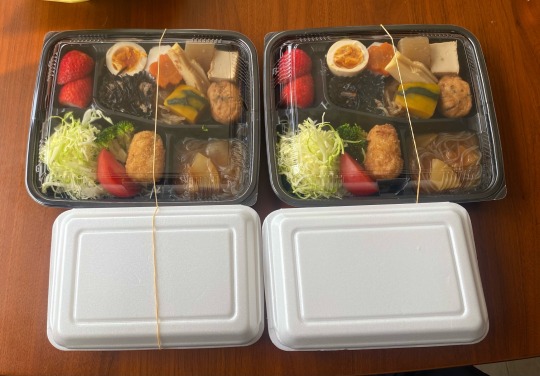
A colorful bento for takeout! The strawberries were a great surprise. The big compartment contains marinated hijiki seaweed (the black stuff), a miso egg, and some seasonal simmered veggies etc.: taro, carrot, daikon, young bamboo, kabocha squash, soft tofu, and a ganmodoki tofu fritter. The noodly stuff is sweet & sour shirataki konnyaku with cabbage, onion, and pineapple, which is kind of unusual (but not bad). Finally, a crab cream croquette with cabbage, steamed broccoli, and tomato. Nice variety and color!
65 notes
·
View notes
Text
Oh my god, another one! They just keep coming!
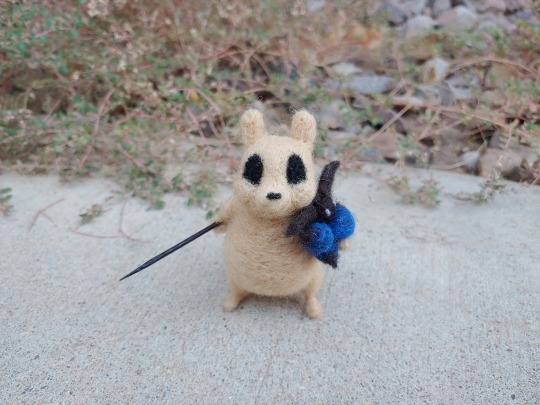
At this point, though, the more the merrier! And this one looks like a jolly little fellow!
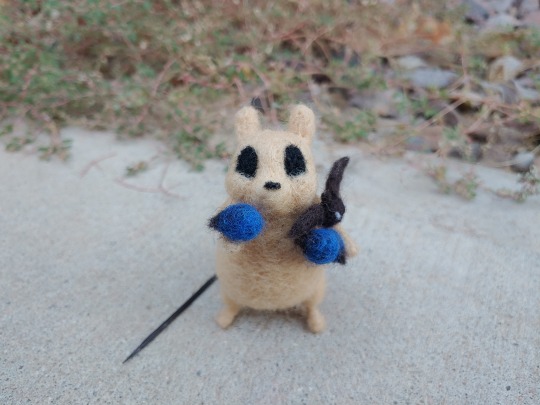
Oh, is that for me? How kind of you, little guy! Though I'm not hungry now.
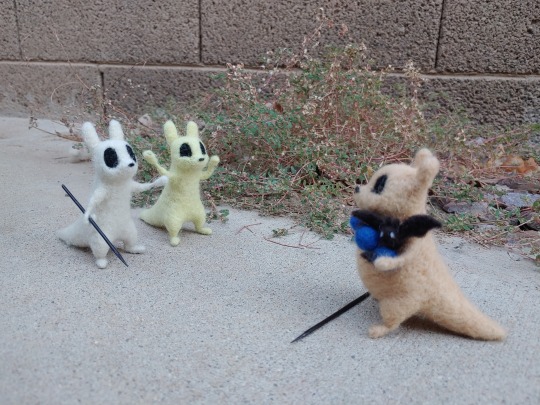
Looks like the others are pretty hungry, though!
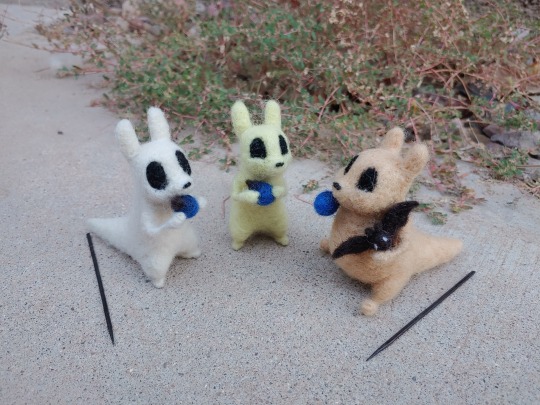
What a cute little picnic! I think I'm gonna like this new little creature...!
-.-.-.-.-.-.-.-.-
Welcome to Rain Wool: Downpour! For the first entry in the series, I've got none other than the one, the only, the chonker of all time, the Gourmand!
Let me tell you, at first I wasn't sure how well this would turn out. Not only did I struggle to find an adequate soft orange-yellow color, but I thought it would be a bit hard to figure out the exact volumes and degree of Gourmand's chubbiness. I usually use a mix of in-game art, sprites, and certain fanart for reference, but even so it can be a little hard to translate them into a 3D form, especially with someone like Gourmand. But nonetheless, I'm really happy with how this guy turned out, and it seems to grow cuter every time I look at it!
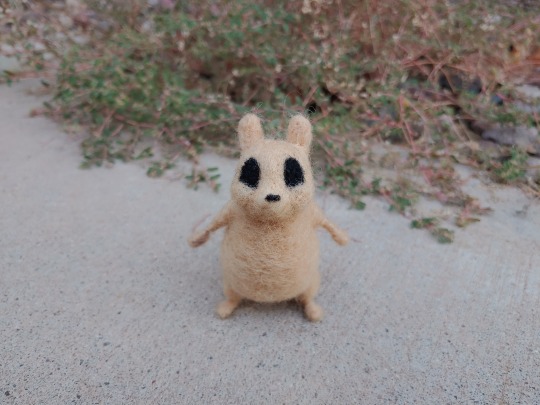
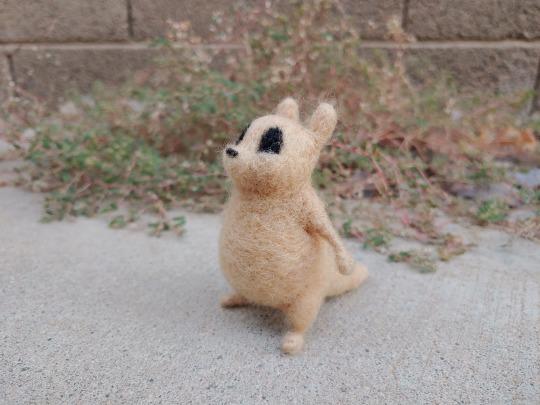
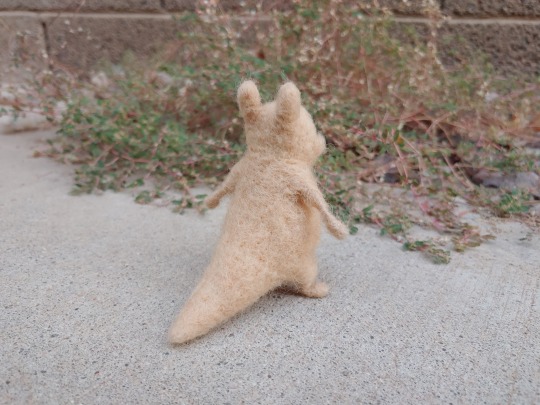
For these characters, I also wanted to try something new. Some recent asks have really helped me realize that I honestly prefer making needle-felted figures as unique toys of sorts rather than traditional look-don't-touch art pieces, so I'll be designing the figures around that purpose.
And as such, to really act on that idea and further bring these slugcats to life, I thought I'd try making a few tiny props for them!
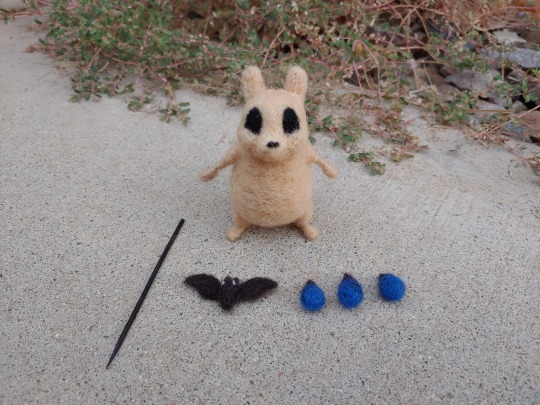
I've got a bunch of more game-accurate spears made from bamboo skewers, and for Gourmand in particular I needle-felted some simple food items! I would've done more variety, but alas I haven't the right wool colors yet to make other foods.
Regardless, I hope you enjoy this little guy as much as I do, and continue to stick around as the rest of the Downpour cast takes up woolen form!
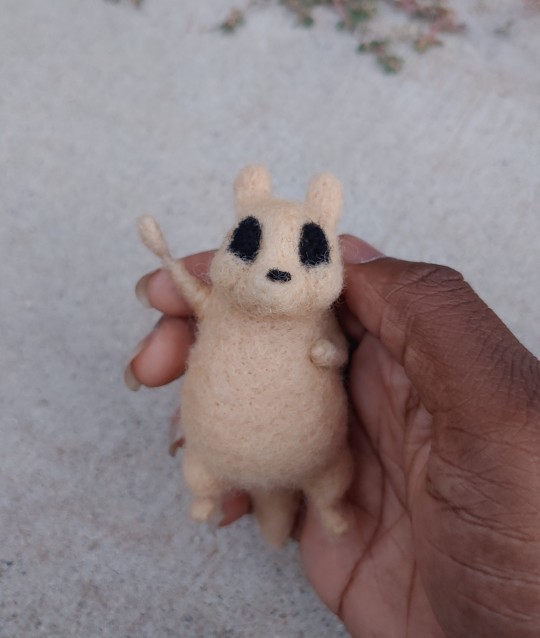
#art#artwork#artists on tumblr#traditional#traditional art#fiber art#needle felting#felting#fanart#rain world#slugcat#rw slugcat#gourmand#rw gourmand#survivor#rw survivor#monk#rw monk#project: rain wool#quetzalli needle felts#honestly sometimes i worry i don't make him chonky enough in my fanart#i really hope i did gourmand justice here
766 notes
·
View notes
Text
Part two of the grainy pics of all the parts Deforest Kelly has played

Vince Grayson - Fear in the night (1947)

Bill Rile - Waco (1966)

Guy Tavenner - Town Tamer (1965)

'Medic' - The Man in the Gray Flannel Suit (1956)

Bob Kirby - Variety Girl (1947)

Charlie - House of Bamboo (1955)


Jim Breck - Tension at Table Rock (1956)

Viking 1 (voice) - The Brave Little Toaster Goes to Mars (1998)

Sam King - Black Saddle, S2 Ep8 Apache Trail (1959)
#deforest kelley#cowboy movies#old films#old movies#1940s movies#1940s#1950s movies#1950s#old animation#brave little toaster#1990s#1990s movies#1960s#1960s movies#de kelley#star trek#star trek cast#bones mccoy
72 notes
·
View notes
Text
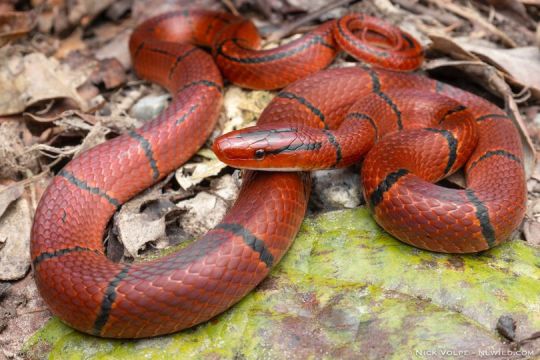
Black-banded Trinket Snake aka Red Bamboo Snake (Oreocryptophis porphyraceus laticinctus), family Colubridae, Malaysia
This variety is sometime called the "Red Mountain Racer".
photograph by Nick Volpe
354 notes
·
View notes